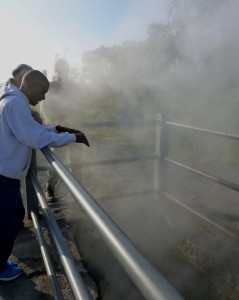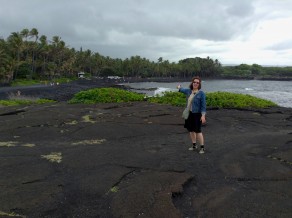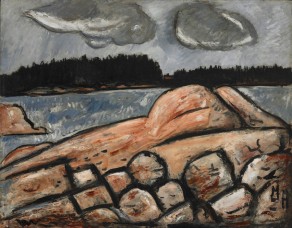
Moses and Michael brought a group of students to the steam vents. We delayed our departure to join them for a few minutes in looking at these natural terrors. Signs cautioned visitors against breathing the vapors. Plume of steam rose at random intervals among the scrub and grasses that grew across the meadows.
Moses headed off on a crater hike with his detachment of art students. Kathie and I got back in the blue Nissan, exited the park and turned left onto the Mamalahoa Highway (Route 11) and headed south through the dense, tangled, steaming cloud forest that covers with higher elevations of Kilauea (4,092 feet above sea level). As the road descended we debouched from the forested area into vertiginous grasslands punctuated by clusters of trees and vegetation, traversed by wide lava fields. Kilauea is a subordinate peak to the southeast of Mauna Loa (13, 679 feet above sea level). Descending to 2,000 feet we then found ourselves on the southern slopes of Mauna Loa, passing ranches and small farms. Grazing cattle, horses and goats populated the fields. Traffic was light. Descending further the rain tapered off sharply and the grasses were transformed from lush green to golden sunburn. We would encounter the reverse effect later in the day, crossing the Saddle Road from Kona to Hilo, passing the northern extremity of Mauna Loa. At 1,000 feet we could see the highlands of South Point rising ahead of us. We had wanted to drive down to the headland, but were advised that it would be folly to do so without a rugged four-wheeler. Our feeble front-wheel drive Nissan ruled that out. Approaching an intersection near the bottom of a long hill, I intuitively turned left onto Ninole Loop Road, which took us down to the county park. Driving past the beach we parked near a series of pavilions full of family cookouts. The majority of people on site were Hawaiian or Asian, with a handful of Haole visitors stopping to take pictures. The indigenous people are physically attractive, according to conventional standards. Being fit in youth, by middle age many seem to become very large—both men and women. Tattooage is very common among all segments of the population on the Big Island. Some of the more elaborate tattoos might cover a person’s chest or arms. On a number of occasions I saw indigenous people wearing tattoos of traditional native design. Many of the first early modern Europeans to decorate their bodies with tattoos were mariners returning from the Pacific.
The black sand beach of Puna’lu’u is a common tourist destination, as is the green sand beach at Papakōlea, closer to South Point. Embracing an inclined crescent of granular gunmetal pounded by light surf and shaded by palm trees, two rugged quays of Pahoehoe lava reach out to the sea, then bend back along the coastline.

Neglecting to pack swimming attire, we walked along the southern margins of the site, in the barbecue-scented air. A latticework of bleached grass had been trampled flat as it pushed its way up between cracks in the black stone. I unpacked my journal and colors at a concrete picnic table near the rest rooms. Kathie wandered off closer to the water. The Big Island landscape challenges many of the clichés of Pacific island imagery and European conventions of landscape painting. The Marquesas from whence the ancestors of the indigenous people had come nearly two thousand years ago, and where Gauguin ended his days, are far to the south of the Hawaiian archipelago. The active volcanism, combined with several distinct climate zones has created an environment quite different than what I had expected to find. Unifying leitmotifs are the ubiquitous coconut palm trees and Haole tourists.

During my French-easel summer at Skowhegan forty-two years ago, one of the resident artists was a painter who affected the appearance of a Monet, dressed in white, wearing a dark beard and wide-brimmed hat. His was accompanied on his daily excursions to the motif by a coterie of acolytes.
Blue! He declared. Only Claude could paint the distance, and it is blue.
I have always cherished a bemused contempt for cults of personality—especially if they are presided over by American Francophiles. One of the visiting artists was a landscape painter who lived in the Camden Hills. He commented that only a fool would tackle the Maine landscape with a French esthetic. The place has a spirit all its own. Capturing the effect of the cold, hard light and deep shadows cannot be achieved without using the color black—which was anathema to self-described colorists admiring of Corot, Impressionism, the Nabis and Marquet.

Marsden Hartley got it. Wyeth gets it. In the Maine woods and along its rocky shores black is a color.
Halfway around the globe, in very different terrain, the same holds true.
(To be continued)